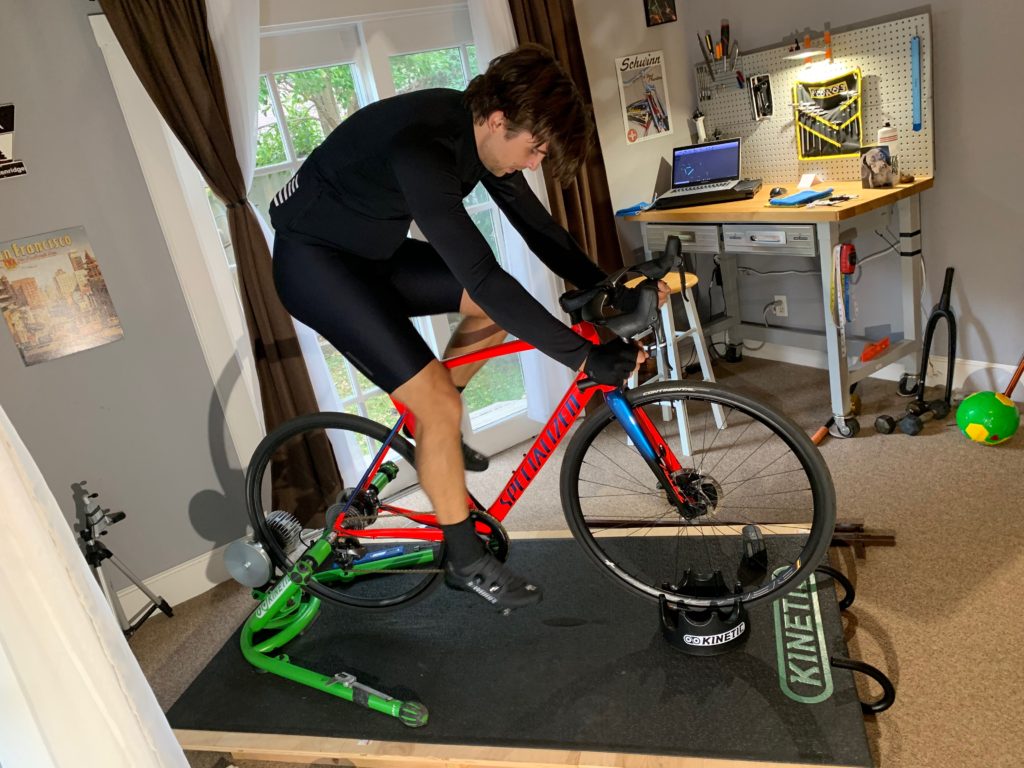The 1x (1 by) Road bike is a relatively new concept as it has all the characteristics of a normal road bike geometry, rear derailleur, tube shape…but does not include the front derailleur/shifter paddle/cables and chainrings. The 1x Road Bike excels on the flats, crit course and in certain cases rolling terrain.
The intent of the 1x road bike is simplicity. The lack of or need for a second chainring means no front derailleur, fewer cables, a better understanding of shifting, reduced weight, and a very clean look.
The athlete whose bike is featured the pic went through the entire bike fit process – a process (in a nutshell) that includes measuring the leg, trunk and foot and then comparing those measurements to the geometry of the bike which results in a fit solution. With the solution in hand, it was time to examine the existing conditions of the bike and then start making changes.
Bike Data
- Brand: Specialized
- Model: Allez Sprint X1
- Size: 56cm
- Year: 2019
- Notables: 1x drivetrain and Smartweld Sprint Technology
Fit Data
- The first step is to check saddle fore/aft which in this case required a rather sizable adjustment. Based upon the athlete’s hip dismensions he needed to be 55 millimeters from centerline to saddle sweet spot and instead he had the saddle set at 35 millimeters from the centerline to saddle sweet spot.
- The next step is to check the saddle tilt. The tilt was measured at -0.3 degrees measured from the sweet spot of the saddle. Considering the aggressive above horizonatal i.e. bar drop (this bike is meant for rides at or below 2 hours and to be ridden on flat rides at a high intensity) I set the bike at -1.5 degrees (slightly lower nose tilt accommodates the aggressive torso angle).
- Fit Fact: A saddle with a tilt greater then -3 degrees can cause numb hands and instability.
- The third step is to check Saddle height. The height was extremely was close to spot on so only a small adjustment (plus 2 mm in height) was necessary.
- The fourth step is to check effective body extension (measured from the sweet spot of the saddle to the center of the handlebar). The athlete did a great job of mirroring his current bikes effective body extension and as a result of the fore/aft adjustment and stem length, the alignment was within 3-5 mm of the fit solution so no further adjustment was necessary.
- The fifth was to configure headset spacers and or above horizontal alignment (bar drop). The Allez Sprint is an aggressive bike designed to position the athlete with an aggressive torso angle and the alignment at that point in the fit was 75 to 80 mm above horizontal (bar drop). Considering the athlete’s flexibility and experience on the bike I recommended that the current alignment was sufficient and if necessary additional spacers could be removed but it was important to get mileage on the bike prior to making the bar drop more aggressive i.e. lowering the torso angle.
- Next, I assessed the hoods and bar angles. The hoods are somewhat subjective when it comes to measuring so visual assessment is key – one key point is wrist angle (too much bend in the wrist can limited control, access to the brakes.shifters and can cause soreness and or a numbing sensation. The alignment of the hoods were correctly positioned but the bar angle was causing then to angle downward resulting in pressure on the wrist so I adjusted the angle by 3 degrees upward and reduced the pressure on the wrist.
- Last I set the athlete’s double-checked the cleats. No shifting had occurred so the cleats were left as is.
Conclusion
After a long warm-up on the trainer and multiple hard efforts, I was pleased with the athlete’s position on the bike. I asked the athlete for feedback and based on the changes made he felt that the small adjustments were not noticed but that the bike especially the bar drop felt powerful and pressure on the perineum felt comfortable.. The end result of the fit can be seen in the pic below.
